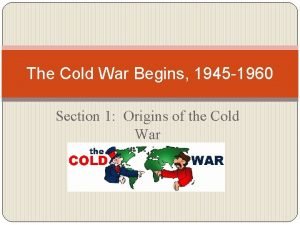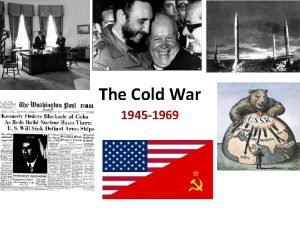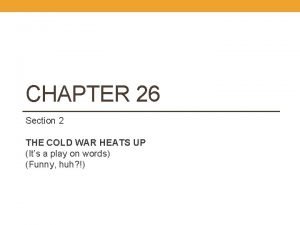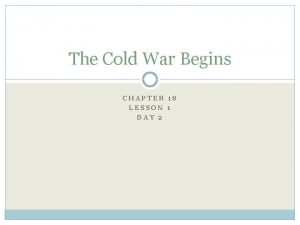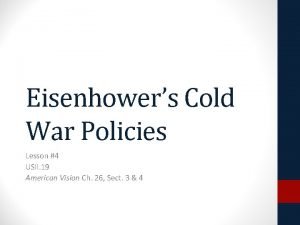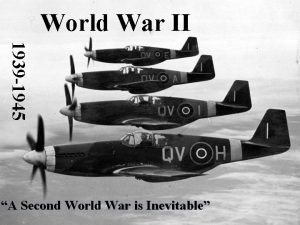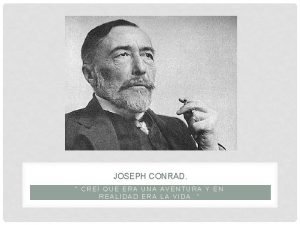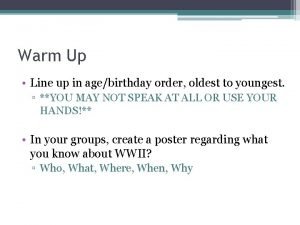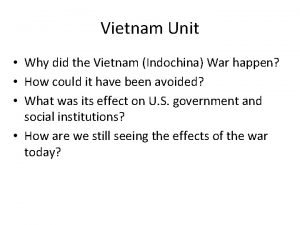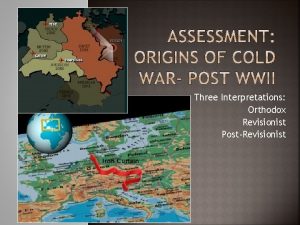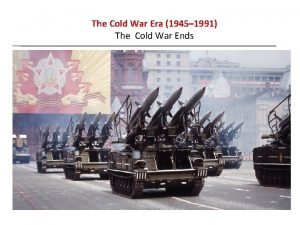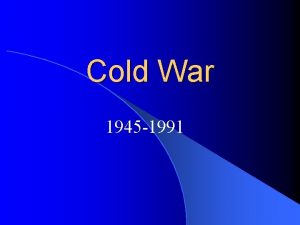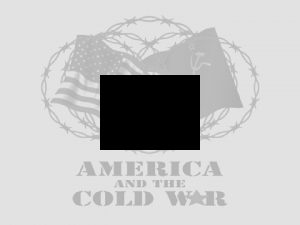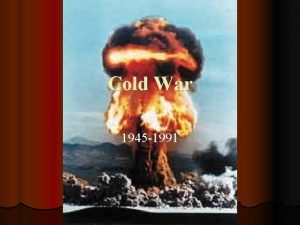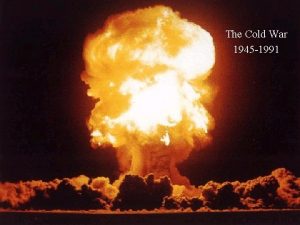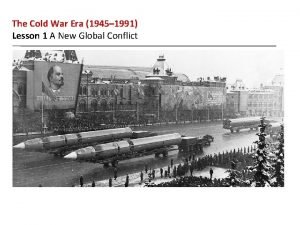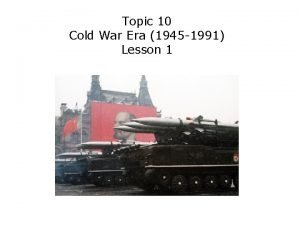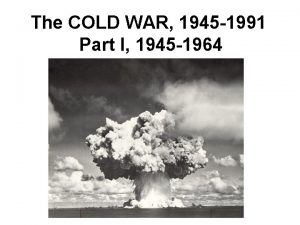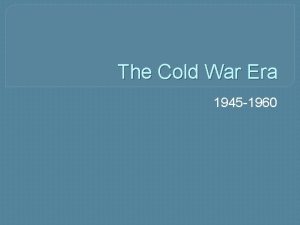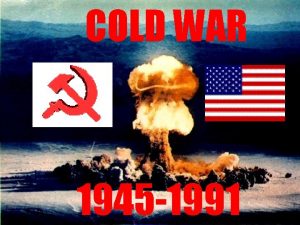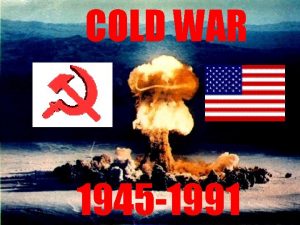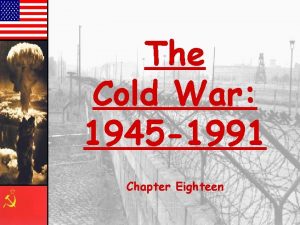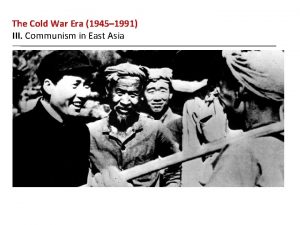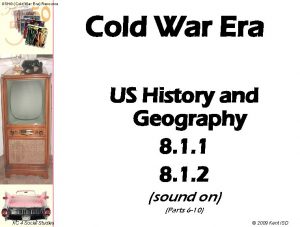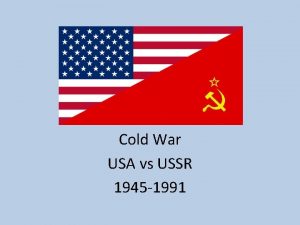The Cold War Era 1945 1991 Lesson 3


















- Slides: 18

The Cold War Era (1945– 1991) Lesson 3 Communism in East Asia

The Cold War Era (1945– 1991) Lesson 3 Communism in East Asia Learning Objectives • • • Analyze how Mao Zedong turned China into a communist state. Describe China’s role in the Cold War. Explain the causes and impact of the Korean War.

The Cold War Era (1945– 1991) Lesson 3 Communism in East Asia Key Terms • • • Mao Zedong collectivization, Great Leap Forward, Cultural Revolution. 38 th parallel Kim Il Sung, Syngman Rhee. Pusan Perimeter, demilitarized zone (DMZ),

The Chinese Communist Victory Civil war raged across China during the late 1940 s as Mao Zedong (mow dzuh doong) and his Communist forces fought to overthrow Jiang Jieshi’s Nationalists. In 1949, Mao’s forces triumphed. The defeated Jiang and his supporters fled to the island of Taiwan. After decades of struggle, China was finally united, with the Chinese Communists in control. They renamed the country the People’s Republic of China.

The Chinese Communist Victory • • • How the Communists Won Remaking Chinese Life Communism Takes a Huge Toll Great Leap Forward Fails The Cultural Revolution

The Chinese Communist Victory The support of Chinese peasants helped Mao Zedong (left) and the communists achieve victory in China’s civil war.

The Chinese Communist Victory Analyze Graphs Failed government policies combined with bad weather led to a severe famine and millions of Chinese deaths. During which year of the Great Leap Forward was the death rate highest?

China and the Cold War The Communist victory in China dominated the Cold War in the years after 1949. The United States had supported Jiang Jieshi in the civil war. After Jiang fled to Taiwan, the United States continued to support the Nationalist government there, providing military and economic aid as it faced shelling from the mainland. For decades, the United States refused to recognize the People’s Republic of China, or, as many Americans called it, “Red China. ”

China and the Cold War • • • An Uneasy Alliance with the Soviet Union China and the United States The Nationalists in Taiwan

China and the Cold War Analyze Political Cartoons The Soviet Union and China, both communist, had a tense relationship. In 1978, China rejected a Soviet proposal to improve relations. Who does the bear represent? Who has the upper hand in this cartoon?

China and the Cold War Analyze Maps Taiwan and China had an uneasy relationship during the Cold War. Why might it prove difficult for China to invade Taiwan?

The Two Koreas In 1950, the Cold War erupted into a “shooting war” in Korea, a peninsula on the northeastern edge of Asia. The Korean War pitted UN forces, largely from the Western democracies, against communist North Korea, which was supported by the Soviet Union and China. It was a key event of the Cold War.

The Two Koreas • • • A Nation Divided The Korean War Begins China Responds Korea Remains Divided South Korea Prospers North Korea Isolates Itself

The Two Koreas Analyze Maps War broke out in Korea in 1950. Communist North Korea invaded South Korea in an effort to reunite Korea. In the fall of 1950, who controlled most of the Korean Peninsula?

The Two Koreas UN forces battled Chinese and Soviet-backed North Korean troops for control of the Korean Peninsula. In August 1950, advancing U. S. soldiers march past a line of Korean refugees.

Quiz: The Chinese Communist Victory Both the Great Leap Forward and the Cultural Revolution A. B. C. D. forced people to move to communes. challenged peasants to work in industry. were movements to encourage youth. led China to periods of chaos.

Quiz: China and the Cold War When China’s alliance with the Soviet Union collapsed, the United States A. B. C. D. joined with the Chinese in an alliance against the Soviets. grew closer to the Soviets because of the situation in Korea. stayed neutral and uninvolved with China. played the “China card” to isolate the Soviets.

Quiz: The Two Koreas North Korea’s economy A. is a command economy in which the government makes all important economic decisions. B. grew extensively after the Korean War and continues to grow today. C. has gradually evolved from a command economy into a market economy. D. compares favorably with South Korea’s, which is an inefficient command economy.
 Lesson 1 the origins of the cold war
Lesson 1 the origins of the cold war The cold war begins 1945-1960
The cold war begins 1945-1960 The cold war heats up: 1945 - 1969
The cold war heats up: 1945 - 1969 The cold war heats up chapter 26 section 2
The cold war heats up chapter 26 section 2 America confronts the post-cold war era
America confronts the post-cold war era Proxy wars
Proxy wars Lesson quiz 18-1 the cold war
Lesson quiz 18-1 the cold war Lesson 4 eisenhowers cold war policies
Lesson 4 eisenhowers cold war policies Truman speech
Truman speech 1945 world war ii
1945 world war ii 1945 world war
1945 world war Chapter 16 lesson 2 challenges to slavery
Chapter 16 lesson 2 challenges to slavery Era quiz: the baroque era
Era quiz: the baroque era Victorian era vs elizabethan era
Victorian era vs elizabethan era Creí que era una aventura y en realidad era la vida
Creí que era una aventura y en realidad era la vida Era uma estrela tão alta era uma estrela tão fria
Era uma estrela tão alta era uma estrela tão fria Acrostic poem for cold war
Acrostic poem for cold war Napalm vietnam war
Napalm vietnam war Postrevisionist
Postrevisionist

